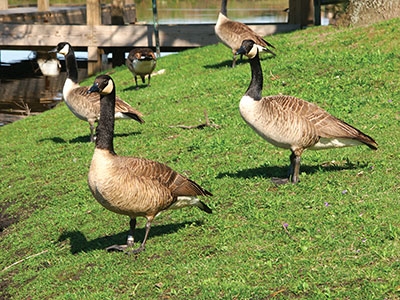
FAO Urges Increased Precautions
By Sarah Ferguson
Features Barn Management Production Poultry Production ProductionThe risk of re-emergence of avian influenza A viruses requires increased surveillance and precautions
 Proper biosecurity practices go a long way toward keeping your birds protected against diseases that are transmissible by wild fowl.
Proper biosecurity practices go a long way toward keeping your birds protected against diseases that are transmissible by wild fowl. As flu seasons begins, the risk of re-emergence of avian influenza A viruses (AIVs) increases. In light of this, the Food and Agriculture Organization of the United Nations (FAO) is urging increased precautions and continuous surveillance by all countries.
Past AIV outbreaks have caused huge economic losses in the food and agriculture industry. The H7N3 AIV outbreak in British Columbia in 2004, for example, caused an estimated loss of over $300 million.1 Of even greater concern, however, is the potential risk of livestock-to-human transmission of AIV causing zoonotic disease, and the recent outbreak this year of the deadly H7N9 reported in China exemplifies this. While this outbreak may seem to be far away geographically, experience with the Toronto SARS coronavirus outbreak in 2003 illustrates just how closely we are linked by air travel in a way that nullifies any geographic distance.2
AIVs are classified as either highly pathogenic, which cause high mortality rates in poultry species and can infect humans, or low pathogenic, which are commonly associated with mild clinical symptoms in birds.3,4,5
Wild bird populations provide a continuous reservoir for the pathogenic AIVs, but high pathogenic strains are not usually found in these populations.5 Recent surveillance statistics show no evidence of highly pathogenic AIVs in Canadian bird populations, but low pathogenic viruses have been identified in most provinces, including Ontario.6 Because of its high pathogenicity in humans, there is concern about the H7N9 subtype in China, but because of its low virulence in birds, it remains difficult to detect and monitor disease transmission.
Most highly pathogenic AIVs belong to the H5 and H7 subtypes, and their occurrence must be reported to the OIE World Organisation for Animal Health.5 Those that are highly pathogenic are believed to arise in poultry through genetic mutations that occur after infection with a low pathogenic strain from wild birds.4,7 Transmission occurs primarily via infected fecal matter and contaminated water, but it also can occur via inhalation of infectious particles.5 Since most poultry barns in Canada are contained populations, risk of transmission arises from secondary transfer by humans, vehicles and machinery moving among barns.8 Other risk factors for AIV infection include the age of the bird, stocking density, ventilation and temperature.4 Swine populations are also particularly important in the transfer of disease, since they can become infected by both avian and human influenza and could act as mixing vessel of genetic material.4 Human infection is thought to occur from contact with infected avian species, uncooked poultry products, or contaminated manure, vehicles and surfaces.9
The current diagnostic test for AIV infection involves real-time RT-PCR (reverse transcription-polymerase chain reaction) detection of viral genes, and this is successfully being used worldwide.10 Samples are preferably taken from the upper or lower respiratory tract of the animal, in addition to blood, but the samples can also be collected from rectal swab or spinal fluid.11
Since there is no treatment for AIV infections, the only way of eliminating it is through the culling of infected flocks. Vaccinations are widely used in many countries, but proper management programs are necessary for successful results and ongoing viral antigenic drift may influence their effectiveness.12
Canada’s prevention program against AIVs involves intense surveillance of wild avian populations to predict areas that may be at risk for an outbreak, as well as strict importation regulations of avian products.13 Proper implementation of intensive biosecurity protocols is also extremely important for protecting our avian flocks and public health.
References:
$1. Skowronski DM et al.,Canadian Medical Association Journal 2007, 176: 47-53
$2. Normile D, Science 2013, 339: 1269-1273
$3. Alexander DJ, Vet Microbiol 2000, 74: 3-13
$4. Alexander DJ and Capua I, World`s Poultry Science Journal 2008, 64: 513- 533
$5. Clark L And Hall J, The Auk 2006, 123: 3-29
$6. Canadian Cooperative Wildlife Health Center: Avian Influenza Virus Reports 2013, http://www.ccwhc.ca/aiv_bird_surveys_2013.php
$7. Capua I and Alexander DJ, Poultry Science 2009 88: 842–846
$8. Burns TE et al., Transboundary and Emerging Diseases 2011, 58: 510–518
$9. Public Health Agency of Canada: Human Health Issues relates to Avian Influenza in Canada 2006, http://www.phac-aspc.gc.ca/publicat/daio-enia/index-eng.php
$10. World Health Organization: Weekly epidemiological record 2013, 88: 401-412
$11. World Health Organization: Collecting, preserving and shipping specimens for the diagnosis of avian influenza A (H5N1) virus infection 2006, WHO/CDS/EPR/ARO/2006.1
$12. Capua I, Rev. sci. tech. Off. int. Epiz., 2007, 26: 217-227
$13. Canadian Food Inspection Agency: Overview of Avian Influenza Prevention, Preparedness and Response, http://www.inspection.gc.ca/animals/terrestrial-animals/diseases/reportable/ai/prevention-preparedness-and-response/eng/1375982718329/1375982719875
This article was an assignment by Sarah Ferguson in the fall 2013 Animal Health course (POPM4230) taught by Dr. N.A. Karrow, Department of Animal and Poultry Science, University of Guelph, Guelph, Ont.
Print this page